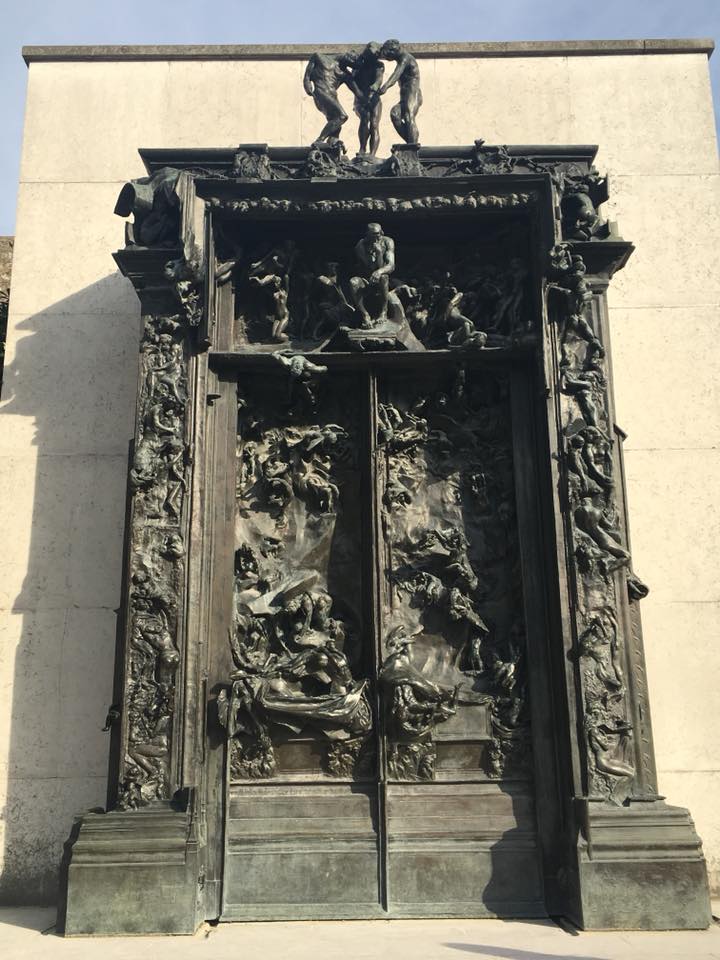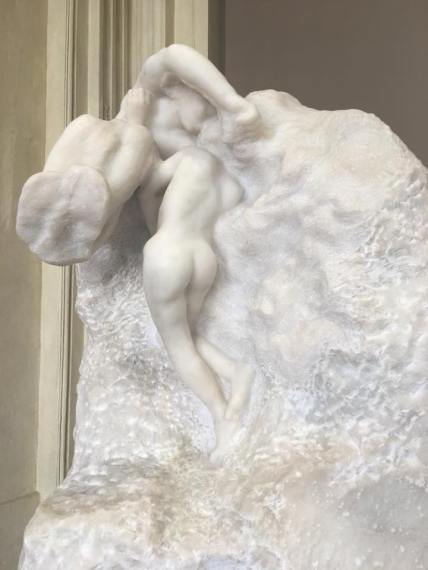The day we visited Petit Palais in Paris

Its courtyard garden was blazing with spring blossoms.
We didn’t spend a lot of time inside
Long enough to adore its grand airy atmosphere and the spiral staircase.
Upon exiting the building, we walked to Pont Alexandre III

Said to be the most ornate and extravagant bridge in Paris
with its golden statues glistening under sunlight.
It was there we caught our first glimpse (of the day) of the Eiffel Tower.

For lunch, my friend Johanna resolved to satisfying her burger and fries cravings 🙂 where I settled for a salad.

There is a time in our journeys where we seek the familiarity that reminds us of home.
After lunch, we headed to the Rodin Museum. My friend is not a huge fan of sculptures, so she stayed in the garden watching her favorite TV show, while I roam the museum floors finding Rodin, Camille Claudel and a small collection of paintings by Van Gogh, Monet and Renoir. Below are some of my favorites, as curated by the museum.

When conceived in 1880 in its original size (approx. 70 cm) as the crowning element of The Gates of Hell (shown below) , seated on the tympanum, The Thinker was entitled The Poet. He represented Dante, author of the Divine Comedy which had inspired The Gates, leaning forward to observe the circles of Hell, while meditating on his work.

This image of a man lost in thought, but whose powerful body suggests a great capacity for action, has become one of the most celebrated sculptures ever known.

The Kiss originally represented Paolo and Francesca, two characters borrowed, once again, from Dante’s Divine Comedy: slain by Francesca’s husband who surprised them as they exchanged their first kiss, the two lovers were condemned to wander eternally through Hell.

This group, designed in the early stages of the elaboration of The Gates, was given a prominent position on the lower left door, until 1886, when Rodin decided that this depiction of happiness and sensuality was incongruous with the theme of his vast project. He therefore transformed the group into an independent work and exhibited it in 1887. The fluid, smooth modelling, the very dynamic composition and the charming theme made this group an instant success.

Made in Brussels, The Age of Bronze, one of Rodin’s most famous works, attests to the sculptor’s masterly skill and his attention to living nature that informs the pose and the modelling.

A young Belgian soldier, Auguste Ney, was the model for this statue devoid of any element that would shed light on the subject’s identity.

Carved in stone and still covered in toolmarks, The Cathedral is a combination of two right hands, belonging to two different figures.

Very similar to The Secret

this work belongs to the series carved in marble, most frequently after 1900, such as The Hand of God
and Hands of Lovers

But, more broadly, it emphasizes Rodin’s fondness and passion for these hands, which he isolated, like the fragments in his collection of Antiques, in order to give them a more finished and autonomous form.
Next, two pieces from Camille Claudel – The Age of Maturity

The Age of Maturity (1893-1900) is probably the work that most lends itself to an interpretation based on autobiographical narrative: the end of the relationship between Claudel and Rodin. In actual fact, the association of the three figures with Camille Claudel, Auguste Rodin and Rose Beuret arose some time after the sculpture was first exhibited. The critics initially saw it as the “symbolic representation of Destiny, in which the ageing man is torn away from love, youth and life”. The work was a turning-point in Claudel’s career, a key moment, when she attained the full mastery of her powers, when she began to be recognized by the establishment, but when she realized she would never reach the heights that she could justifiably hope for. In the first version, the man stands in the centre, torn between two women, one old, the other young. The second version, full of powerful movement, intensifies the drama: this time the man turns his back on the imploring figure of the young woman, having letting go of her hand, and is led away by an old woman who also depicts Time.
The Waltz

A couple of graceful dancers seemingly carried away by a whirlwind.
If you love sculptures, the museum could easily take 4-6 hours. I was a bit concerned about my friend getting bored waiting outside, so I finished everything in just a little over 2.5 hours. It was not enough and I would definitely be back for a revisit!
Coming up next in the Travel section: Dinner at L’Astrance, Paris.
























Awesome pictures and what beauty. Thanks for the wonderful share.
LikeLiked by 1 person
Thank you Boundlessblessings!
LikeLiked by 1 person
Welcome.
LikeLike
Just heaven!
LikeLiked by 2 people
Thank you Melanie!
LikeLiked by 1 person
Lovely pictures and one for my next trip to Paris.
LikeLiked by 1 person
You do that Sheree. I hope you have a fantastic time there!
LikeLiked by 1 person
I loved the Rodin museum – thanks for the lovely memories and your photos are great.
LikeLiked by 1 person
Thank you Sue!
LikeLiked by 1 person
Never been to Musée Rodin, although I’ve heard so many good things about it that I might make the visit over next time I’m in Paris!
LikeLiked by 2 people
Yes, I was surprised how fascinating it was. I need to go back and complete my visit too.
LikeLiked by 1 person
That is an awesome museum, so sad your friend missed it. Definitely go back and enjoy by yourself or with someone who enjoys the works like you do.
LikeLiked by 1 person
Thanks Terry. I plan to 🙂
LikeLiked by 1 person
Last time I was at the Musée Rodin I was surprised to find everything enclosed in glass. The time before it was all open and you could feel the energy of the pieces. Either way, is a wonderful place to visit. Your photographs are wonderful and make me want to return…soon.
LikeLiked by 1 person
Wow, Wouldn’t it be nice to see the sculptures not encased. I know exactly what you mean. Thank you for stopping by!
LikeLike
Beautiful photos! Those cherry blossoms are so pretty
LikeLiked by 2 people
Marvelous photos! The blossoms are so nice and the Rodin…..so strong and powerful. His work evokes real emotion for me. Thanks for sharing this Paris!
LikeLiked by 1 person
What a beautiful post! Amazing art.
LikeLiked by 1 person
Oh my gosh, you really captured the essence of Paris and your shots are amazing!
LikeLiked by 1 person
Beautiful pics esp the spring blossoms!
LikeLiked by 1 person
Ohh, my. Lovely sculptures and trees, but what a door!!! 😮
LikeLiked by 1 person
Yes – to my door expert lady!
LikeLiked by 1 person
😉 Thank you!
LikeLiked by 1 person
Thanks for the virtual tour! My parents had an end table size copy of The Kiss when I was growing up and I always admired it. Several of the pieces you included here I hadn’t seen pictures of before. I still love his style to this day.
LikeLiked by 1 person
We loved Rodin. His mansion was under renovation when we visited so we didn’t get to go in. We visited in Feb/Mar and the weather was surprisingly warm. We saw a couple of bunnies in the yard.
LikeLiked by 2 people
There’re still bunnies in Paris? So the French had not eaten them all 🙂
LikeLiked by 1 person
ha! We saw a few in the garden.
LikeLiked by 1 person
Superb. I’ve just returned from a trip to the British Museum in London where they currently have an exhibition entitled Rodin And The Art Of Ancient Greece. Some excellent examples of his work alongside a number of antiquities from The Parthenon. Rodin was clearly a genius.
LikeLiked by 2 people
Awesome. I’m heading to London in the summer Thanks to the tip. I will check it out!
LikeLiked by 1 person